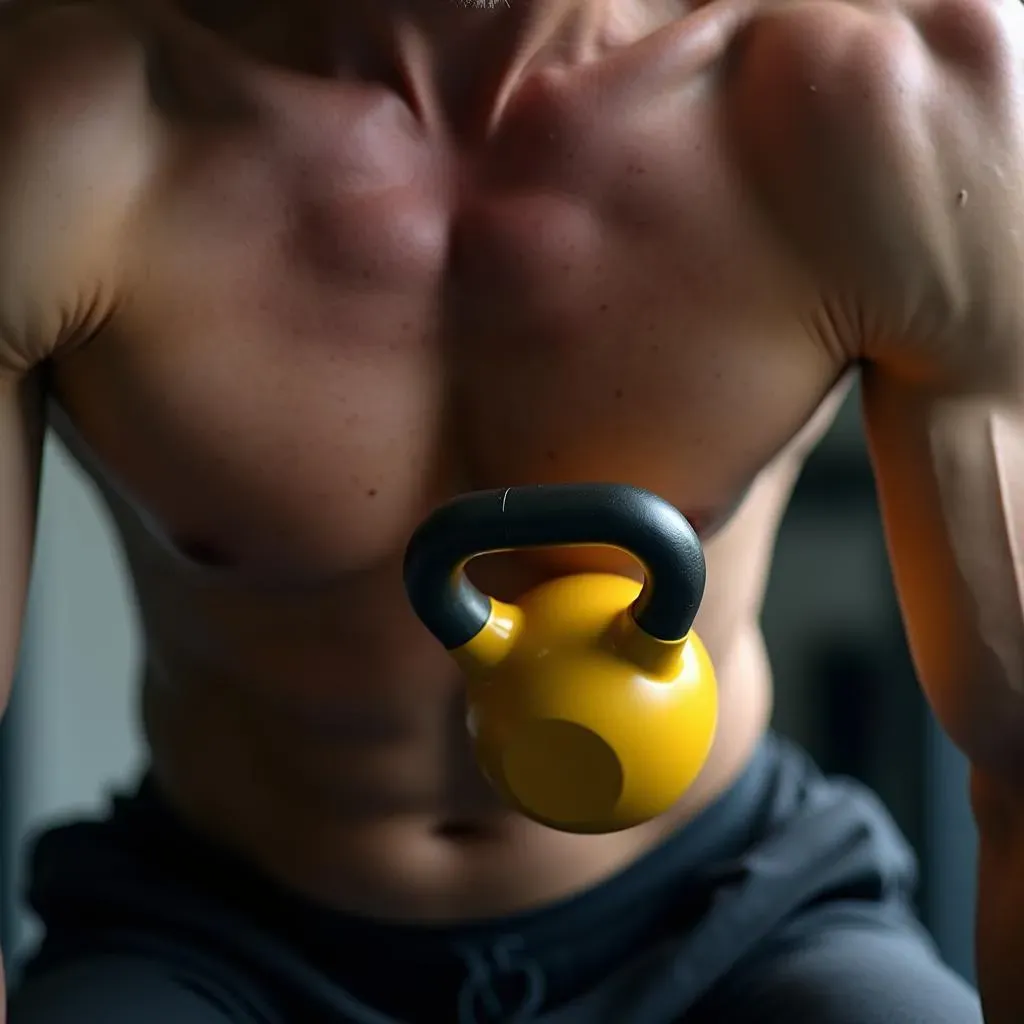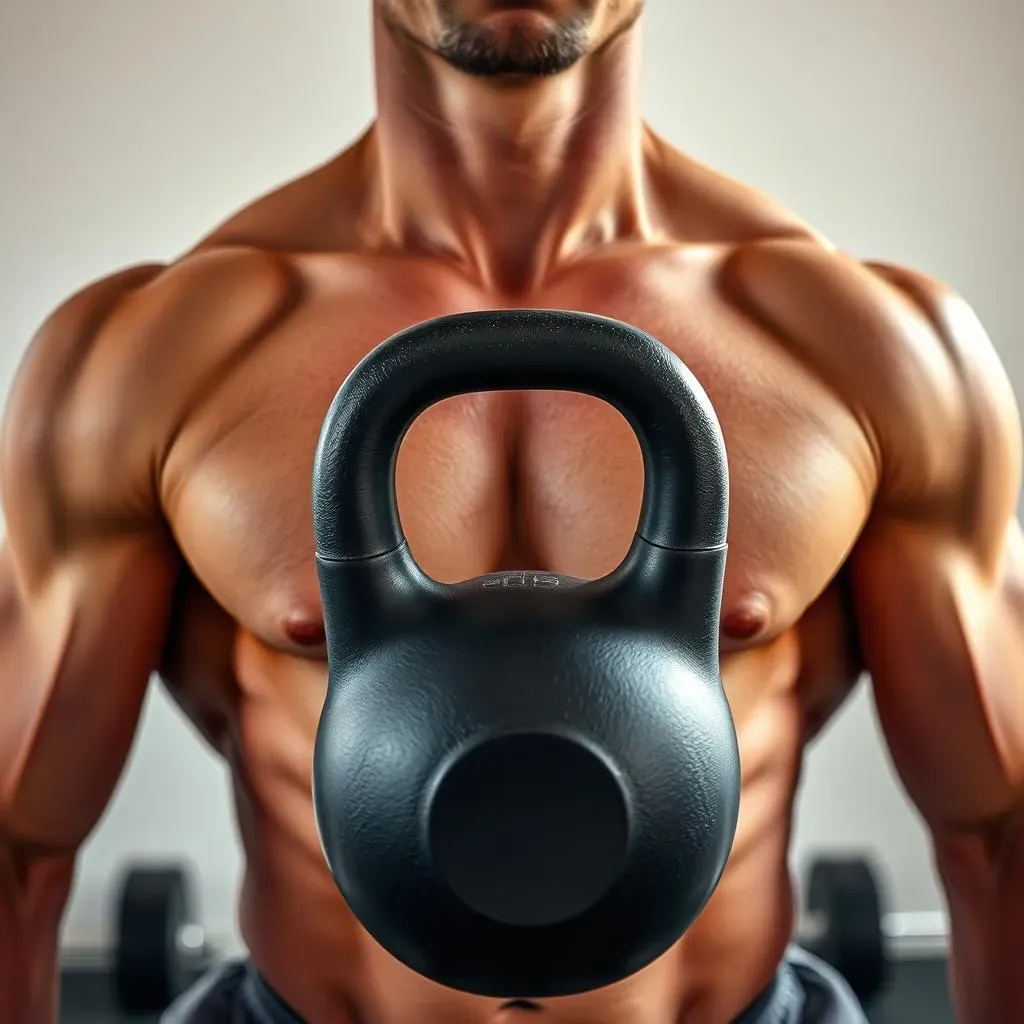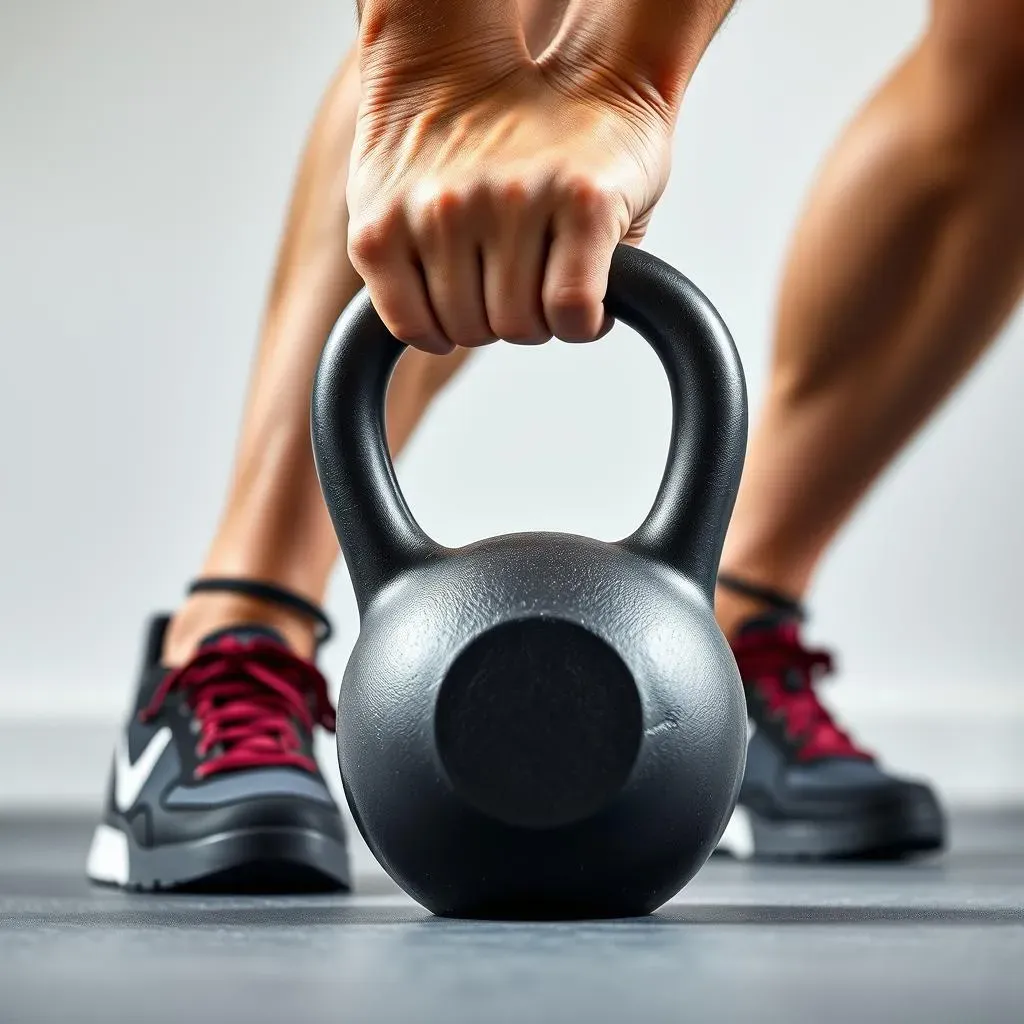Table of Contents
Tired of the same old chest routine? Are you always reaching for those dusty dumbbells or the crowded bench press? It's time to shake things up and explore the world of chest workouts with kettlebell. These cannonball-shaped weights aren't just for swings and squats; they're secretly amazing for building a strong, sculpted chest. This article is your guide to unlocking the power of kettlebells for chest gains. We'll skip the fluff and get straight to the good stuff. First, we'll uncover why kettlebells are a surprisingly effective tool for chest development, not just for your legs and core. Then, we'll dive into five must-try exercises that will target your chest muscles from all angles, giving you a workout you'll actually feel. Finally, we'll wrap it up with essential tips and techniques to make sure you're getting the most out of your chest workouts with kettlebell, helping you achieve those strength and size goals. So, grab your kettlebell, and let's get started!
Why Kettlebells Are a Game Changer for Chest Workouts

Why Kettlebells Are a Game Changer for Chest Workouts
Beyond the Basics:
Unconventional Chest Training
let's be real, when you think "chest day," barbells and dumbbells probably jump to mind first. I get it, I used to be the same. But here's the thing: kettlebells bring a whole new dimension to chest training. They're not just about swinging and squats, despite what some might think. The offset weight of a kettlebell demands more from your stabilizing muscles, forcing your chest to work harder and smarter than it would with a balanced dumbbell. It’s like trying to do a push-up while balancing on a slightly unstable surface - suddenly, you're engaging a whole bunch of extra muscle fibers you didn't even know you had.
I remember when I first tried the kettlebell floor press. It felt so different from a standard dumbbell press. The way the weight shifts and pulls, it hits your chest in a way that’s just... unique. I was sore in places I had not felt before and that was a welcome surprise. It's not just about lifting heavy; it's about controlling the weight and feeling the muscle contract. And that's where the kettlebell really shines.
More Than Just Strength:
Stability and Function
Kettlebells aren't just about building pure strength; they're fantastic for developing functional fitness. Because of their unique shape, kettlebells force you to engage your core throughout the entire movement, which is a huge benefit. This means that while you're working your chest, you're also strengthening your abs, back, and shoulders. It's like a full-body workout disguised as a chest day. Think of it as a two-for-one deal!
Benefit | Description |
|---|---|
Enhanced Stability | Kettlebells challenge your stabilizer muscles, improving overall balance and control. |
Functional Strength | Movements mimic real-life activities, building strength that transfers to everyday tasks. |
Core Engagement | You're constantly working your core to stabilize the kettlebell, creating a full-body workout. |
Space-Saving and Versatile:
Train Anywhere
Let’s face it, not everyone has a home gym with a full rack of weights. I lived in a tiny apartment for years, and space was always a major issue. That's where kettlebells become your best friend. They take up very little space, and you can get a killer chest workout using just one or two. You don't need a fancy bench or a ton of equipment, just a kettlebell and a bit of floor space. You can literally work out anywhere, from your living room to the park. It’s perfect for those who don't have the time, space, or money for a full gym setup.
I remember taking my kettlebells with me on vacation. While everyone else was stuck in the hotel gym, I was outside doing my chest workout with a beautiful view. It was a total game changer for my routine. The versatility and convenience of kettlebells are what make them such a great tool for any fitness enthusiast.
Five Killer Kettlebell Exercises to Sculpt Your Chest

Five Killer Kettlebell Exercises to Sculpt Your Chest
1. The Kettlebell Floor Press:
Your New Best Friend
let's start with the basics, but with a twist. The kettlebell floor press might seem simple, but it's a powerful way to hit your chest. Lie on the floor with a kettlebell in one hand. Press the weight straight up, just like you would with a dumbbell, but notice how the kettlebell's unique shape changes the game. The weight shifts around, making your chest work harder to stabilize it. I like to think of it as a regular press on hard mode. It's not just about pushing the weight; it's about controlling the movement and squeezing your chest at the top. You'll feel it, trust me.
When I first started, I was surprised at how much this simple exercise activated my chest muscles. I was used to the standard bench press, but the floor press with a kettlebell felt entirely different. It’s a great way to build strength and get that mind-muscle connection going. It's also a lot more shoulder-friendly than some other pressing exercises. And, let's be honest, it's nice to give your shoulders a break sometimes.
2. Kettlebell Bench Press:
Elevate Your Routine
Time to take things up a notch. If you have a bench, the kettlebell bench press is your next go-to move. It’s similar to the floor press, but with the added range of motion. Lie on the bench, holding a kettlebell in each hand. Press them straight up, focusing on squeezing your chest at the top. The instability of the kettlebells will make your chest work harder to stabilize the weight. I like this exercise because it helps me achieve a deeper chest stretch and a more powerful contraction. It's like the floor press, but with more freedom to move.
I remember the first time I did this exercise, I was a bit shaky. But with practice, I got the hang of it. And the results? Well, let’s just say my chest was thanking me. This move is not just about lifting the weight; it’s about controlling the movement and feeling the muscle work. If you have a bench, you need to be doing this. And if you don't have a bench, you might want to consider getting one; it's a great addition to any home gym.
3. Incline Kettlebell Press:
Hitting Upper Chest
Don't forget about your upper chest! The incline kettlebell press is the perfect way to target those often-neglected muscles. Set your bench to an incline, grab your kettlebells, and press them upwards. The incline angle changes the focus, making your upper chest work harder. It’s like a regular bench press, but with a different emphasis. I personally love this exercise because I find it helps me achieve a more balanced chest development. It targets those upper chest muscles that are sometimes hard to reach.
I have to admit, this exercise took me a while to master. The incline makes it a bit trickier to control the kettlebells, but the payoff is worth it. The feeling of a good squeeze in your upper chest is pretty awesome. And it’s not just about aesthetics; a strong upper chest is important for overall strength and stability. So, if you want to take your chest game to the next level, the incline kettlebell press is a must. Here's a quick tip: start with a lighter weight than you usually use for flat presses, and focus on maintaining good form.
Exercise | Focus | Why It's Great |
|---|---|---|
Kettlebell Floor Press | Overall Chest | Great for beginners, builds a strong base. |
Kettlebell Bench Press | Overall Chest | Increased range of motion, builds more strength. |
Incline Kettlebell Press | Upper Chest | Targets those hard-to-reach upper chest muscles. |
Maximizing Results: Tips and Techniques for Kettlebell Chest Workouts

Maximizing Results: Tips and Techniques for Kettlebell Chest Workouts
Progressive Overload:
The Key to Gains
so you've got the exercises down, that's awesome! But lifting the same weight for the same reps every time isn't going to get you very far. You need to challenge your muscles to grow, and that's where progressive overload comes in. It's a fancy way of saying you need to gradually increase the stress on your muscles over time. I remember when I first started, I was so excited to lift heavier, but I didn't really understand the importance of doing it gradually. I ended up with some minor injuries and had to take a break. Learn from my mistakes, okay? You can do this by either increasing the weight, reps, or sets. Or, you can decrease the rest time. It doesn't have to be a huge jump every time, small and consistent changes are key.
When I started focusing on small increments, that's when things really started to change for me. It’s not about ego lifting; it’s about building a solid foundation and making consistent progress. Think about it like this, you're not trying to sprint; you're trying to build a marathon of strength. And that takes time, patience, and a smart approach to your training. So, don't get caught up in trying to lift the heaviest weight possible right away. Focus on mastering the movement and gradually increasing the difficulty, and you'll see the results.
Mind-Muscle Connection:
Feel the Burn
It's not just about going through the motions, you have to actively engage the muscles you're targeting. This is what people call the mind-muscle connection. When you're doing a kettlebell press, focus on squeezing your chest muscles at the top of the movement. Feel the muscle contract and work. I used to just try to lift the weight, and I didn't really focus on the muscle itself. But once I started concentrating on my chest during each rep, I noticed a huge difference. It's like you're sending a message to your muscles saying, "Hey, you're the star of the show!"
This is not just some woo-woo concept, it's a scientifically proven way to improve your workout. When you focus on the target muscle, you recruit more muscle fibers, leading to greater gains. So, before you start your next set, take a moment to visualize your chest muscles working and focus on feeling them contract. It might sound a little strange, but I promise, it makes a huge difference. You're not just lifting weight, you're sculpting your body with intent. And that's pretty awesome.
Tip | Description |
|---|---|
Progressive Overload | Gradually increase weight, reps, or sets over time. |
Mind-Muscle Connection | Focus on feeling the chest muscles work during each rep. |
Double Progression:
A Smart Approach
Let's get a little nerdy for a moment, double progression is a great concept. It’s a strategy that combines adding reps and then weight, and it's something that I’ve found really useful for kettlebell training. Instead of jumping straight to a heavier weight, you first aim to increase the number of reps you can do with the current weight. Once you can comfortably hit the top of your rep range, then you can increase the weight. For example, if you're doing floor presses with a 16kg kettlebell, and your goal is 8-12 reps, you should aim to hit 12 reps consistently before you move up to 20kg. This approach helps you avoid a big jump in weight that might compromise your form.
I remember when I first tried this method, my lifts felt so much smoother. I was able to maintain good form and focus on the muscle contraction. It’s a great way to ensure you're not sacrificing quality for quantity. And let's be honest, we all want to get the most out of our workouts, right? Double progression is a smart way to do that. It helps you stay consistent and make steady gains over time. It's not about rushing the process; it's about respecting it and making progress in a sustainable way.
Listen to Your Body:
Rest and Recovery
Look, I know it’s tempting to go all out, every single workout. But your body isn’t a machine, it needs time to rest and recover. This is where a lot of people mess up, me included. I remember pushing myself too hard and then wondering why I felt burnt out all the time. Now, I make sure I get enough sleep, eat a balanced diet, and take rest days when I need them. It's not about being lazy; it's about being smart. Your muscles grow when you're resting, not when you're working out.
If you're feeling sore, take a day off. If you're feeling tired, get some extra sleep. Don't push yourself to the point of injury or burnout. You're in this for the long haul, so you need to take care of yourself. I like to think of rest days as active recovery. I'll do some light stretching or go for a walk. It helps me feel refreshed and ready for the next workout. Remember, progress isn't a straight line; it's a journey with ups and downs. The key is to be consistent and listen to your body along the way.
- Increase reps before weight.
- Prioritize rest and recovery.
- Listen to your body.
Wrapping Up: Your Kettlebell Chest Journey
So, there you have it—a solid foundation for building a powerful chest with kettlebells. They're not just a trendy piece of gym equipment; they're a versatile tool that can provide a challenging and effective workout. Remember, consistency and proper form are key. Don't rush the process, focus on controlled movements, and progressively increase the weight or reps as you get stronger. Whether you're at home or in the gym, kettlebells offer a space-efficient and adaptable way to train your chest, along with other muscle groups, and achieve those gains you are working for. Now go and unleash the beast, and make those pecs pop!